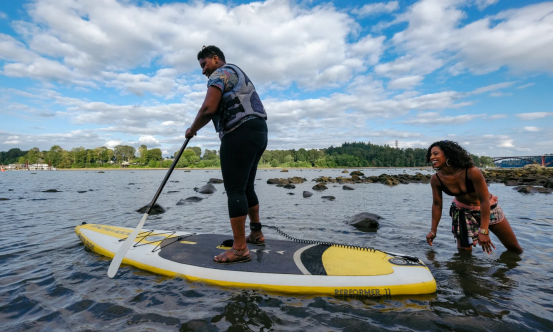Paddleboarding, a sport that combines the tranquility of floating on water with the excitement of surfing, has surged in popularity across all age groups. It's celebrated not only for the unique perspective it offers on the water but also for its accessibility to enthusiasts of all skill levels. This growing trend has attracted a diverse community, from those seeking a serene paddle on a quiet lake to adventurers riding ocean waves. So, is paddle boarding hard for beginners?
This blog aims to demystify paddleboarding for newcomers, addressing common concerns and offering solutions to typical pain points. Our goal is to transform apprehension into confidence, making paddle boarding a joyous activity for beginners. With this guide, you’ll find paddleboarding much easier than you imagined.
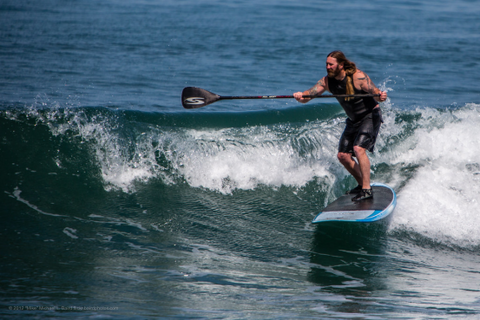
How to choose the right paddle board
Selecting the ideal paddle board is the first step towards a successful and enjoyable experience in the water. The choice between an inflatable and a rigid (hard) board significantly influences your paddle boarding journey. Here's what you need to know:
Inflatable paddle boards vs. rigid paddle boards
- Inflatable Boards: Known for their convenience and portability, inflatable paddle boards are easy to transport and store, making them ideal for those with limited space or who wish to travel with their board. They are surprisingly durable and provide ample stability for beginners, although they might feel slightly different underfoot compared to rigid boards.
- Rigid Boards: Constructed from materials like fiberglass, epoxy, or wood, rigid boards offer superior performance in terms of speed and maneuverability. They are the preferred choice for more experienced paddlers or those who prioritize performance in their paddle boarding activities. However, they require more storage space and can be more challenging to transport compared with their inflatable counterparts.
What you should consider before choosing a paddle board
- Weight Capacity: Selecting a board that can comfortably accommodate your weight is crucial for both your safety and the board's performance. Boards burdened beyond their weight limit tend to be less stable and more challenging to control.
- Length of the Board: The board's length plays a significant role in its speed and how well it maintains a straight path through the water. Longer boards excel in touring and long-distance journeys due to their superior tracking ability. In contrast, shorter boards offer greater maneuverability, making them ideal for surfing and leisure paddling.
- Width of the Board: Stability is paramount, especially for those new to paddleboarding. Wider boards, typically in the range of 30-34 inches, provide a more stable base, significantly aiding beginners in finding their balance and confidence in the water.
Tips for selecting your first paddle board
- Consider Your Primary Use: Decide whether you'll be mostly paddling on calm lakes, exploring coastal inlets, or surfing waves. This will guide your choice between a more stable board (inflatable or wide rigid) and one designed for performance (narrower, longer rigid).
- Think About Storage and Transportation: If you have limited space or plan to travel frequently with your board, an inflatable might be the best option.
- Don't Overlook the Weight Capacity: Ensure the board you choose can comfortably support your weight plus any gear you plan to bring along.
- Opt for a Package Deal: Many beginners find value in purchasing a paddle board package that includes a paddle, leash, and sometimes even a carry bag and pump (for inflatables).
Choosing the right paddle board involves balancing your needs, preferences, and the conditions you anticipate encountering. Take the time to research and, if possible, test different boards before making your decision.
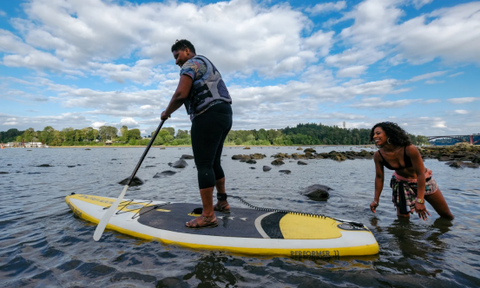
What gear do you need for safe and enjoyable paddle boarding?
Equipping yourself with the right gear and safety equipment is crucial for a safe and enjoyable paddle boarding experience. Here’s a breakdown of the must-have items every paddler should have:
Must-Have Equipment:
- Paddle: Choosing a paddle that’s the right length is vital. A general rule is to select a paddle that’s about 6 to 8 inches taller than you are for optimal efficiency.
- Leash: A board leash keeps your paddle board attached to you at all times. In the event of a fall, your board won't drift away, making it an essential safety item, especially in strong currents or winds.
- Life Vest (PFD): A Personal Flotation Device is a non-negotiable safety item. Opt for a comfortable, well-fitting PFD designed for paddle sports, ensuring it doesn’t restrict your movement while paddling.
- Waterproof Bag: To keep your belongings dry and safe, a waterproof bag is indispensable. These bags can store items like your phone, keys, and snacks, protecting them from water damage.
Safety and Protection:
- Life Vest and Leash Use: Always wear your life vest (PFD) when on the water, regardless of swimming ability. The leash should be securely attached to your ankle or calf, ensuring your board remains within reach at all times.
- Sunscreen: Water reflects and intensifies sun rays, increasing the risk of sunburn. Apply a broad-spectrum, water-resistant sunscreen with a high SPF rating every two hours.
- Clothing: Wear clothing suited to the conditions. On hot, sunny days, long-sleeved shirts made of lightweight, breathable fabric offer protection against the sun. For cooler conditions, consider a wetsuit or drysuit to maintain body temperature.
By prioritizing this essential gear and adhering to safety recommendations, paddle boarders can significantly reduce risks and enhance their overall experience on the water.
Mastering standing, balancing, and paddling skills
Embarking on your paddleboarding journey can significantly shift from initial shaky efforts to smooth sailing with the right foundational skills. Here’s a guide to mastering the essential techniques:
Standing up on your board
-
Begin in a Kneeling Position: Start by kneeling on your board, using your hands for additional stability.
-
Transition to a Crouch: Gradually move from your knees to a squatting position, maintaining hand contact with the board for support.
-
Rise to Stand, One Foot at a Time: Replace your kneeling position with one foot, then the other, into a standing position, ensuring you slightly bend your knees for balance.
Finding your balance
- Feet Positioning: Position your feet parallel, about hip-width apart, near the center of the board. This stance maximizes balance.
- Body Posture: Keep your knees slightly bent to absorb any movement from the water. Your back should be straight, and your gaze forward, which helps in maintaining balance.
Basic paddle strokes
- Forward Stroke: The most fundamental stroke, used to propel the board forward. Dip the paddle into the water close to the board and pull it back towards your feet, keeping your arms straight and twisting from your torso.
- Reverse Stroke: Essentially the opposite of the forward stroke, used to stop or move backward. Push the paddle forward through the water.
- Sweep Stroke: Used for turning the board. Perform a wide, sweeping stroke from the front of the board to the back on one side to turn in the opposite direction.
Acquiring these fundamental skills will significantly boost your confidence while paddling and elevate your overall paddleboarding experience. By practicing these techniques in tranquil waters, you'll soon navigate your board effortlessly, enjoying every moment on the water.
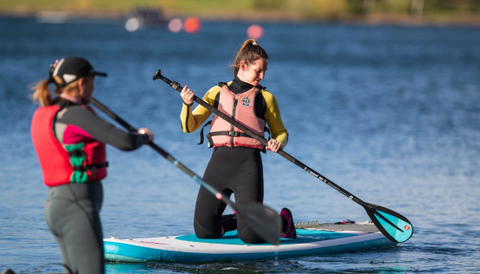
Ensuring the environment is ideal for paddle boarding
Before setting out on your paddle boarding adventure, understanding your environment is crucial. Always check the weather forecast and water conditions; strong winds, currents, and waves can significantly impact your experience, especially as a beginner. Look for calm, sheltered areas known for being beginner-friendly, avoiding busy boat lanes or areas with strong currents. Familiarize yourself with local regulations regarding waterway use to ensure you're not inadvertently breaking any rules.
Furthermore, it's crucial to honor wildlife and their natural habitats by keeping a safe distance and avoiding any disturbance. This respect aids in the conservation of ecosystems and ensures both your safety and a pleasant experience for everyone involved. This mindfulness towards nature enhances the enjoyment and sustainability of outdoor activities.
How can you overcome common paddle boarding challenges?
Paddleboarding, like any outdoor activity, comes with its set of hurdles. Knowing how to navigate these can make your time on the water more enjoyable and rewarding.
Dealing with the fear of falling and getting back on
Falling off your paddle board is a normal step in the learning curve, so there's no need for alarm. For your safety, always wear a life vest, and learn to fall away from the board to minimize the risk of injury. To remount, approach your board from the side, seize the central handle, and use a kicking motion with your legs as you pull yourself back onto the board. This technique ensures a smoother and safer return to your paddling adventure.
Maintaining balance in various water conditions
- Calm Waters: Start in calm, flat water to master your balance without external factors.
- Waves and Wake: When facing waves, position your board to meet them head-on, bending your knees more deeply to absorb the motion. In wake, keep your knees bent and your weight centered, ready to adjust your balance as needed.
- Windy Conditions: In wind, lower your stance by bending your knees and keep the paddle close to the board for more control.
Handling fatigue and knowing when to take breaks
Paddleboarding can be physically demanding, leading to fatigue, especially for beginners. Listen to your body and take breaks as needed. If you feel tired, kneel or sit on your board to rest and conserve energy. Staying hydrated and nourishing your body with snacks during longer sessions is also crucial.
Understanding and preparing for these challenges can significantly enhance your paddle boarding experience, turning potential obstacles into manageable aspects of your adventure on the water.
How can you improve your paddle boarding skills with practice?
-
Starting in calm, shallow waters
-
Taking short but regular practices
-
Joining local paddle boarding groups
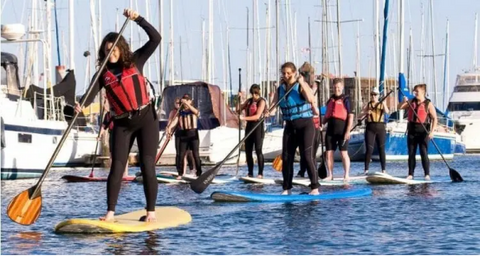
Summing up
With the right mindset and preparation for paddleboarding, you’ve already set the foundation for success. Is paddle boarding hard to beginners? Actually, every expert was once a beginner; progress is inevitable with practice. Let’s embrace the adventure that awaits on the water. We warmly invite you to join the vibrant paddle boarding community, where support, friendship, and new experiences flourish.
 EN
EN JA
JA